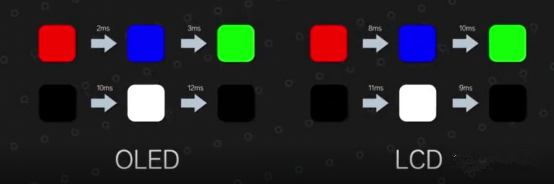OLED has no backlight layer, and each pixel can be switched on and off independently, so it doesn't need the entire backlight layer to light up once it's on like an LCD screen.

The first advantage:
Always on display. When the screen is locked, we can light up some pixels individually to display important information such as the time and notifications at a low brightness and refresh rate. As the LCD screen is turned on, the entire backlight layer of the screen needs to be turned on, so it is naturally impossible to achieve this function with low power consumption.

The second advantage:
Almost infinite contrast. Contrast ratio refers to the ratio of brightness between black and white in an image. The higher the contrast ratio, the brighter and richer the color. A low contrast image will look like a watercolor painting, while a high contrast image will look like an oil painting.

For an LCD to display pure black, the ideal condition is for the liquid crystal molecules to be completely closed, completely blocking the emitted backlight. But the liquid crystal layer of LCD has a very fatal problem, the liquid crystal molecules can’t be completely closed. As a result, when black is displayed, white fibrous light is emitted, so instead of pure black, the screen is seen as grey with a sharp decrease in brightness.

The OLED screen itself has no backlight, and each pixel can be controlled independently, directly cutting off the power supply to the black pixels, so that it does not emit light at all, achieving the true sense of pure black.

The third advantage:
No light leaks. Because the LCD screen has a backlight layer, the interface between the screen and the frame, the backlight layer is easy to leak out. In the display of pure black screen, there will be a large area of halo phenomenon at the border, this is called light leakage. The OLED screen itself does not have a backlight. Each pixel emits light independently, so the pure black display is turned off, making light leakage impossible.

The fourth advantage:
Response time is short. The screen doesn't always show a static image. To show a dynamic image means that each pixel needs to change colors quickly, and the time it takes to change colors is the screen response time. If the response time is too long, the pixels cannot change the color when the dynamic picture is displayed. As a result, the next picture will be displayed before the last picture completely disappears, resulting in residual shadows on the screen. LCD screen color switching is accomplished by controlling the deflection of the LCD layer, so the speed of the LCD layer deflection directly determines the grey response time of the LCD. The deflection of the liquid crystal layer is related to temperature, and the lower the temperature, the slower the deflection speed, which leads to the LCD screen at low temperature will appear obvious dragging phenomenon, which is obvious on the mobile phone.
OLED screens have no liquid crystal layer and are not limited by the liquid crystal layer and temperature. The OLED screen has a very short response time to switch colors between colors, making it almost impossible to drag.

OLED screens take much longer to switch from pure black to white, or from white to black, than other colors. It also takes less time to switch between black and white than most LCDS, so OLED screens have a natural advantage when it comes to displaying dynamic images.

The fifth advantage:
Ultra-thin thickness, good malleability. OLED screens have no backlight layer and no liquid crystal layer, so they can be made very thin. LCD has a backlight layer, a liquid crystal layer, and some polarizers, so LCD thickness is thicker than OLED. A thinner screen means you can fit a bigger battery or reduce the thickness of the phone, which is crucial to the design of the phone.

OLED screens can bend as much as paper, while CDS have a backlight layer and a liquid crystal layer. The backlight layer and the liquid crystal layer are hard substrates and can only bend very small amounts, which can only be seen on a large panel like a desktop display, but cannot be achieved on a mobile phone.
The sixth advantage:
Low power consumption. When the LCD turns the screen on, the entire backlight is lit, so whenever the screen is on, whatever is displayed is constantly consuming power. OLED screens use more power than LCDS when they are pure white, but each pixel can be turned on and off independently, so the brightness can be turned down or even off separately. For everyday use, OLED screens generally last better than LCDS unless they're stuck in white for long periods of time.







